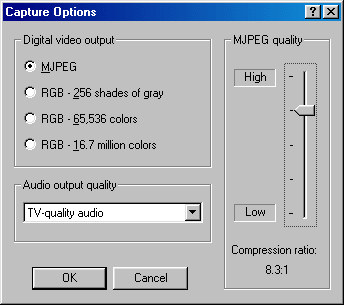Hardware MJPEG: Pros and Cons
The major selling point for the Marvel G200 was the fact that it didn’t simply include a software MPEG2 encoder for video. Instead it used a hardware MJPEG encoder for true to source video capture. This Hardware MJPEG support is once again provided for on the Marvel G400 courtesy of the on-board Zoran ZR36060PQC.
For a card retailing at $300 there is no way to provide support for hardware MPEG2 video capture and editing with the current technology. Instead of offering a software MPEG2 video capture/editing solution Matrox decided to stick to their guns and continue, in their opinion to use the next best thing, hardware MJPEG. Hardware MJPEG is not as efficient as MPEG2 compression but a hardware MPEG2 codec on a sub $300 enthusiast's card is not a reality we can enjoy.

The advantage of the hardware MJPEG codec on the Marvel G400 is that capturing at full D1 resolution can be done without dropping any frames due to the inability of your CPU to keep up with the capture. This is in contrast to the methodologies used by the CPU dependent ATI All-in-Wonder 128 and the 3dfx Voodoo3 3500TV, which perform solely software MPEG2 video captures. Using a software MPEG2 codec to capture video causes the entire workload to be placed onto your CPU and any processes running in the background while this capture is taking place will contribute to dropped frames.
If you look at ATI's All-in-Wonder 128, which only does MPEG2 video capture in software, one of the requirements for capturing MPEG2 at 640 x 480 at 30fps with IBP frames compression (A good technical explanation of this and other MPEG issues is available here) is that you must have a Pentium III processor. The Marvel G400, with its hardware MJPEG, describes the minimum system requirements as a 233MHz AGP enabled system (most likely referring to a Pentium II 233 rather than a Pentium MMX 233).










0 Comments
View All Comments